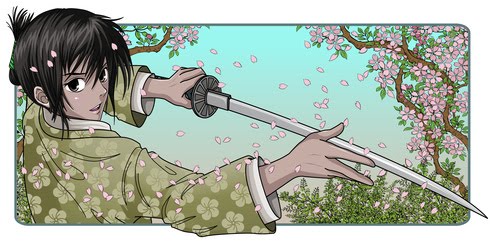Later she gave the sword to her son, Ninigi, who was lord of the earth, which consisted at the time of an archipelago in what is now called the Sea of Japan. The sword was handed down in his family through the generations until it came to his great great grandson, Jimmu Tenno, who is usually thought of as the first emperor of Japan.
Centuries later, during the reign of the twelfth emperor, Keiko Tenno, Ama no Murakumo no Tsurugi was given to the warrior Yamato Takeru when he was sent to pacify treacherous warlords. In a famous incident, the warrior is trapped in dried grassland ignited by flaming arrows. He uses the sword to cut a fire break in the grass, but discovers the power to control the wind. He uses the sword's magic to drive the fire onto his enemies and destroy them. The sword was renamed Kusanagi no Tsurugi (or "grasscutter sword) to commemorate this event.
Kusanagi became one of the official symbols of the Japanese imperial family, along with the sacred jewel and the Yata no Kagami (or "eight-hands mirror"). Kusanagi is kept at the Astuta shrine, but is not available for public display, and its very existence is impossible to confirm. It is not even known what the sword would look like if it were to be displayed. It could be an enormous Nodaichi (or long sword), or a double-edged broadsword, or even something quite different. It may seem anachronistic to imagine it as a Katana, a sword style of the late middle ages, though this is a common representation. But since it is really a magical sword, we might as well say it can have any appearance.

No comments:
Post a Comment